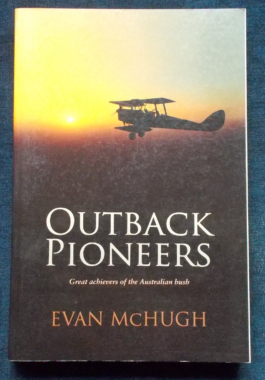-
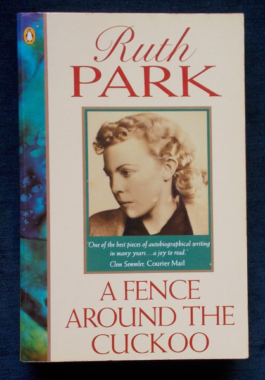 This first volume of Ruth Park’s autobiography is an account of her isolated childhood in the rainforests of New Zealand, her convent education which encouraged her love of words and writing and the bitter years of the Depression. She then entered the rough-and-tumble world of journalism and began a reluctant correspondence with a young Australian writer. In 1942, she moved to Sydney and married that writer, D’Arcy Niland. There she would write The Harp In The South, the first of her classic Australian novels. A Fence Around the Cuckoo is the story of one of Australia’s best storytellers and how she learnt her craft. Illustrated with black and white photographs. https://cosmiccauldronbooks.com.au/p/fishing-in-the-styx-ruth-park/
This first volume of Ruth Park’s autobiography is an account of her isolated childhood in the rainforests of New Zealand, her convent education which encouraged her love of words and writing and the bitter years of the Depression. She then entered the rough-and-tumble world of journalism and began a reluctant correspondence with a young Australian writer. In 1942, she moved to Sydney and married that writer, D’Arcy Niland. There she would write The Harp In The South, the first of her classic Australian novels. A Fence Around the Cuckoo is the story of one of Australia’s best storytellers and how she learnt her craft. Illustrated with black and white photographs. https://cosmiccauldronbooks.com.au/p/fishing-in-the-styx-ruth-park/ -
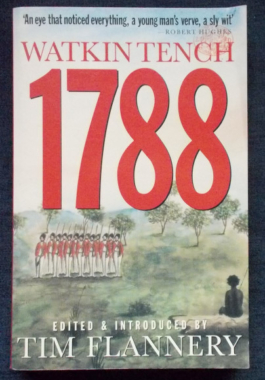
1788: Watkin Tench
$9.00Watkin Tench stepped ashore at Botany Bay with the First Fleet in January 1788. He was in his late twenties, a captain of the marines and on the adventure of his life. Insatiably curious with a natural genius for storytelling, Tench wrote two accounts of the infant colony: A Narrative Of The Expedition To Botany Bay and A Complete Account Of The Settlement At Port Jackson. He brings to life the legendary figures of Bennelong, Arabanoo and Governor Phillip and records the voices of the convicts as they make new lives in their new country. Edited and introduced by Tim Flannery. -

The Right Stuff: Tom Wolfe
$70.00Wolfe began The Right Stuff at a time when it was unfashionable to contemplate American heroism. Nixon had left the White House in disgrace, the nation was reeling from the catastrophe of Vietnam, and in 1979 - the year the book appeared - Americans were being held hostage by Iranian militants. Yet it was exactly the anachronistic courage of his subjects that captivated Wolfe. In late 1940s Americans attempted to break the sound barrier Test pilots were people who live fast lives with dangerous machines - not all of them airborne. Chuck Yeager was certainly among the fastest and was determined to push through Mach 1 - a feat that some had predicted would cause the destruction of any aircraft. Yet soon the focus shifts to the seven initial astronauts, tracing Alan Shepard's suborbital flight and Gus Grissom possibly flooding his Liberty capsule by blowing the escape hatch too soon. There is also an admiring portrait of John Glenn's apple-pie heroism and selfless dedication. Tom Wolfe: "The Right Stuff" became a story of why men were willing - willing? - delighted! - to take on such odds in this, an era literary people had long since characterised as the age of the anti-hero." -
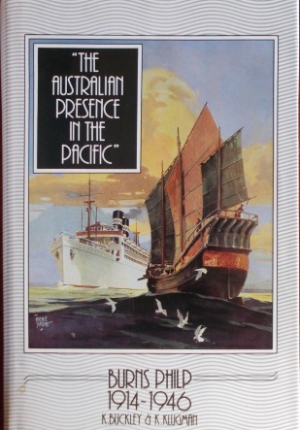 This is the second and final volume of the centenary history of Burns, Philp and Co. During the years reviewed in this volume (1914 - 1946) Burns Philp was firmly established as a merchant in Australia and the South Pacific,renowned as a buyer of copra, a seller of merchandise, plantation owner, shipowner and provider of credit.Within three months of the beginning of World War I, James Burns was carving up the map of the South Pacific; and there is an account of Australian planters acquiring the former German plantations in New Guinea, followed by covert German attempts to re-establish themselves in the Territory. The effects of the Great Depression and the success of the company in coming through it are portrayed vividly.
This is the second and final volume of the centenary history of Burns, Philp and Co. During the years reviewed in this volume (1914 - 1946) Burns Philp was firmly established as a merchant in Australia and the South Pacific,renowned as a buyer of copra, a seller of merchandise, plantation owner, shipowner and provider of credit.Within three months of the beginning of World War I, James Burns was carving up the map of the South Pacific; and there is an account of Australian planters acquiring the former German plantations in New Guinea, followed by covert German attempts to re-establish themselves in the Territory. The effects of the Great Depression and the success of the company in coming through it are portrayed vividly. -

 A wonderful, charming book on the flowers and gardens of Japan - not just any tourist book, but one which also discloses the spirituality behind Japanese garden plans and why they are planned as they are. It was published in 1908 and has fifty beautiful colour illustrations. (See gallery photos for artwork examples) From Chapter II: Stones, Garden Ornaments and Fences. Stones and rocks are such important features in all Japanese gardens that when choosing the material for the making of a landscape garden, however large or however small, the selection of the stones would appear to be the primary consideration. Their size must be in perfect proportion with the house and grounds which they are to transform into a natural landscape, and they will give the scale for all the other materials used - the lanterns, bridges, and water-basins, and even the trees and fences. Their number may vary from five important stones to as many as 138, each with its especial sense and function. I think the correct position and placing of the stones is the part of the art which it would be most difficult for a foreigner to accomplish: the mere names and special functions of the stones would require years of careful study. To the eye of a Japanese one stone wrongly placed would upset all the balance and repose of the picture. Large rocks and boulders seem to be essential for the success of a large garden, and are used to suggest mountains, hills, and the rocks of the natural scene; any very fantastic and artificial looking rocks are avoided, for fear they should give an appearance of unreality to the landscape. The fancy of giving sex to certain stones, and in temple grounds of assigning holy attributes and even of giving them the names of Buddhist deities, dates from very early days, and this custom of applying a religious meaning to the most important rocks survives to this day. Mr. Conder tells us that "formerly it was said that the principal boulders of a garden should represent the Ku, or Nine Spirits of the Buddhist pantheon, five being of standing and four of recumbent..."
A wonderful, charming book on the flowers and gardens of Japan - not just any tourist book, but one which also discloses the spirituality behind Japanese garden plans and why they are planned as they are. It was published in 1908 and has fifty beautiful colour illustrations. (See gallery photos for artwork examples) From Chapter II: Stones, Garden Ornaments and Fences. Stones and rocks are such important features in all Japanese gardens that when choosing the material for the making of a landscape garden, however large or however small, the selection of the stones would appear to be the primary consideration. Their size must be in perfect proportion with the house and grounds which they are to transform into a natural landscape, and they will give the scale for all the other materials used - the lanterns, bridges, and water-basins, and even the trees and fences. Their number may vary from five important stones to as many as 138, each with its especial sense and function. I think the correct position and placing of the stones is the part of the art which it would be most difficult for a foreigner to accomplish: the mere names and special functions of the stones would require years of careful study. To the eye of a Japanese one stone wrongly placed would upset all the balance and repose of the picture. Large rocks and boulders seem to be essential for the success of a large garden, and are used to suggest mountains, hills, and the rocks of the natural scene; any very fantastic and artificial looking rocks are avoided, for fear they should give an appearance of unreality to the landscape. The fancy of giving sex to certain stones, and in temple grounds of assigning holy attributes and even of giving them the names of Buddhist deities, dates from very early days, and this custom of applying a religious meaning to the most important rocks survives to this day. Mr. Conder tells us that "formerly it was said that the principal boulders of a garden should represent the Ku, or Nine Spirits of the Buddhist pantheon, five being of standing and four of recumbent..." -

Was Joan's life so enigmatic as legend would have it? Made use of by the royal court as someone who could be passed off - to the rank and file - as divinely inspired, Joan soon become a headstrong nuisance. And there is nothing more mysterious than her trial and execution. This book is about Joan the girl - not beautiful or mad; nor a liar... but witty, shrewd, fiery and energetic.
-
 Shocking and scandalous stories of the rich, famous and shameless! Smart, educated and accomplished people - often the pillars of society - sometimes behave in the most uncharacteristic and fascinating ways. These are stories of adultery, perversion, shameless greed, theft and deception - scandal at its most raw - that have brought down presidents, prime ministers, clergy and famous people from every walk of life. There's political misconduct; murder and mystery; false prophets; double lives and private perversions of world-recognised names. The scandals climax in catastrophic exposures and career-destroying indiscretions that rival great fiction and are all the more astounding because they are seminal moments in our history. The stories often share selfish desires, yet each tale shocks us - sometimes for its audacity, sometimes for its complexity and sometimes for its pure idiocy. When will people who are in high and public positions realise that they shouldn't get involved in illegal activities or naughty behavior?
Shocking and scandalous stories of the rich, famous and shameless! Smart, educated and accomplished people - often the pillars of society - sometimes behave in the most uncharacteristic and fascinating ways. These are stories of adultery, perversion, shameless greed, theft and deception - scandal at its most raw - that have brought down presidents, prime ministers, clergy and famous people from every walk of life. There's political misconduct; murder and mystery; false prophets; double lives and private perversions of world-recognised names. The scandals climax in catastrophic exposures and career-destroying indiscretions that rival great fiction and are all the more astounding because they are seminal moments in our history. The stories often share selfish desires, yet each tale shocks us - sometimes for its audacity, sometimes for its complexity and sometimes for its pure idiocy. When will people who are in high and public positions realise that they shouldn't get involved in illegal activities or naughty behavior? -
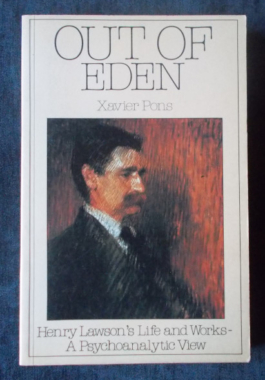 Henry Lawson is still an enigmatic figure in Australian folklore. Both his life and his works lend themselves to widely differing, if not contradictory interpretations. This book, a psychoanalytic view, focuses on clarification of these contradictions and features many hitherto unpublished details of Lawson's life.
Henry Lawson is still an enigmatic figure in Australian folklore. Both his life and his works lend themselves to widely differing, if not contradictory interpretations. This book, a psychoanalytic view, focuses on clarification of these contradictions and features many hitherto unpublished details of Lawson's life. -
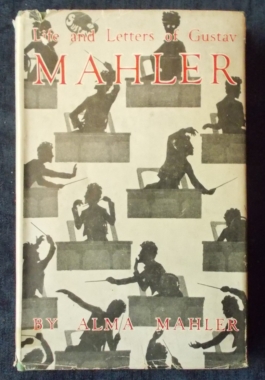 A very vivid picture of Mahler's life and his stormy career as Director of State Opera in Vienna, his habits when composing, his relations with Strauss, Bruckner and others, his later career as a conductor and his death. For much of his life composing was necessarily a part-time activity while he earned his living as a conductor and his compositions were only more readily recognised in the 1940s. His works are generally designed for large orchestral forces, symphonic choruses and operatic soloists. These works were frequently controversial when first performed, and several were slow to receive critical and popular approval; exceptions included his Second Symphony, Third Symphony, and the triumphant premiere of his Eighth Symphony in 1910. The International Gustav Mahler Institute was established in 1955 to honour the composer's life and achievements.
A very vivid picture of Mahler's life and his stormy career as Director of State Opera in Vienna, his habits when composing, his relations with Strauss, Bruckner and others, his later career as a conductor and his death. For much of his life composing was necessarily a part-time activity while he earned his living as a conductor and his compositions were only more readily recognised in the 1940s. His works are generally designed for large orchestral forces, symphonic choruses and operatic soloists. These works were frequently controversial when first performed, and several were slow to receive critical and popular approval; exceptions included his Second Symphony, Third Symphony, and the triumphant premiere of his Eighth Symphony in 1910. The International Gustav Mahler Institute was established in 1955 to honour the composer's life and achievements. -

 Russell started his newspaper career with the Newcastle Chronicle before joining the Daily Express when it was launched by Arthur Pearson in 1900. He eventually moved to the Reuters News Agency where he became a special foreign correspondent. After covering the Gallipoli campaign he became on of the five journalists selected by the government to report the war on the Western Front. Over 1921 and 1922 he accompanied the Prince of Wales, the future Edward VIII, on a tour of Japan and India, writing during the course of the journey, which was, 'by no means conducive to quiet composition...' Illustrated with black and white archival photographs.
Russell started his newspaper career with the Newcastle Chronicle before joining the Daily Express when it was launched by Arthur Pearson in 1900. He eventually moved to the Reuters News Agency where he became a special foreign correspondent. After covering the Gallipoli campaign he became on of the five journalists selected by the government to report the war on the Western Front. Over 1921 and 1922 he accompanied the Prince of Wales, the future Edward VIII, on a tour of Japan and India, writing during the course of the journey, which was, 'by no means conducive to quiet composition...' Illustrated with black and white archival photographs. -

Running Amok: Mark Bowling
$20.00As a journalist, Mark goes where the stories are - from East Timor to cover the struggle for independence, to Aceh and West Papua to report on the separatist crisis and to Ambon where Christians and Muslims wage a bloody war. But he is also a husband and father. Amid the violence he and wife Kim set out to make a home for their family, trying to balance the demands of life as a foreign correspondent with the strangeness of a very different culture and a country running amok. Bowling joined ABC as a reporter in 1985. Illustrated with colour photos on verso of front and back covers. -

The Bush: Don Watson
$22.00Most Australians live in cities and cling to the coastal fringe, yet our sense of what an Australian is - or needs to be - is drawn from the vast and varied inland called 'the bush'. Don Watson explores the bush as it was and as it is now: the triumphs and ruination, the commonplace and the bizarre, the stories we like to tell about ourselves and the national character and those we don't. A fresh examination of our landscape, our unique creatures and ourselves, done in telling, wry detail. Illustrated with black and white and colour photographs. -
 When this work was published in 1969, it was the first full length study of Maria Theresa to be written in English for sixty years. Called to the throne in 1740, at the age of twenty-three, Maria Theresa was wholly unprepared for the events that were to confront her, and trusting in the honour of her fellow monarchs, the young queen found herself with a virtually nonexistent army at the head of a bankrupt and disaffected empire - an empire shortly to be set upon by half of Europe, intent on shattering the Habsburg power for ever. Married to an amiable but ineffectual husband whom she adored, surrounded by shortsighted advisers senile to the point of decrepitude, her only weapons were her charm, her unbreakable will, and her almost reckless courage. With these, and by her own immense exertions, she first held her powerful enemies at bay; then, choosing new advisers with astonishing skill, and discovering in herself a fund of commonsense amounting almost to genius, she instituted wide-reaching reforms which were to unify the Empire's bewildering mixture of lands and peoples, and bring it to the threshold of the revolutionary age. With all this she remained a wife and a mother - most touchingly so in her vast correspondence with her many children.
When this work was published in 1969, it was the first full length study of Maria Theresa to be written in English for sixty years. Called to the throne in 1740, at the age of twenty-three, Maria Theresa was wholly unprepared for the events that were to confront her, and trusting in the honour of her fellow monarchs, the young queen found herself with a virtually nonexistent army at the head of a bankrupt and disaffected empire - an empire shortly to be set upon by half of Europe, intent on shattering the Habsburg power for ever. Married to an amiable but ineffectual husband whom she adored, surrounded by shortsighted advisers senile to the point of decrepitude, her only weapons were her charm, her unbreakable will, and her almost reckless courage. With these, and by her own immense exertions, she first held her powerful enemies at bay; then, choosing new advisers with astonishing skill, and discovering in herself a fund of commonsense amounting almost to genius, she instituted wide-reaching reforms which were to unify the Empire's bewildering mixture of lands and peoples, and bring it to the threshold of the revolutionary age. With all this she remained a wife and a mother - most touchingly so in her vast correspondence with her many children. -
 In 1936, athlete Jesse Owens won four gold medals at the Berlin Olympics. Two years later, boxer Joe Louis won a crushing victory to become heavyweight champion of the world. Despite their fame and success, both men would find themselves barred from certain hotels and would have to eat outside restaurants because of the colour of their skin. However, by their example, they gave hope to millions of black people around the world as they became the first black superstars. Described as a brilliant portrait of the two men, who became close friends despite their very different career paths: within days of Olympic glory, Owens was banned from competing again, and was forced to spend his days racing against horses to earn a living before becoming a spokesman for the sporting ideal. Meanwhile Louis won and lost a fortune, eventually battling with drug addiction and mental illness. This vivid account of their lives away from the public eye and the era in which they lived is compelling and tragic. Illustrated with black and white photographs.
In 1936, athlete Jesse Owens won four gold medals at the Berlin Olympics. Two years later, boxer Joe Louis won a crushing victory to become heavyweight champion of the world. Despite their fame and success, both men would find themselves barred from certain hotels and would have to eat outside restaurants because of the colour of their skin. However, by their example, they gave hope to millions of black people around the world as they became the first black superstars. Described as a brilliant portrait of the two men, who became close friends despite their very different career paths: within days of Olympic glory, Owens was banned from competing again, and was forced to spend his days racing against horses to earn a living before becoming a spokesman for the sporting ideal. Meanwhile Louis won and lost a fortune, eventually battling with drug addiction and mental illness. This vivid account of their lives away from the public eye and the era in which they lived is compelling and tragic. Illustrated with black and white photographs. -

 This biography covers Grant's youth and young manhood from 1822 to 1861. The narrative covers from Grant's birth, his days at West Point; his courtship and marriage, his experiences during the Mexican war, and his subsequent time as a civilian before his comeback as a soldier during the Civil War. His main ambition to become a mathematics tutor at West Point, yet he was diverted into a war of aggression and territorial acquisition which he believed to be fundamentally immoral.Written with the assistance of Lewis' friend and colleague, noted Civil War historian, Bruce Catton, who would go on to write two more volumes covering Grant's wartime career, Grant Moves South and Grant Takes Command finishing the originally-intended trilogy.
This biography covers Grant's youth and young manhood from 1822 to 1861. The narrative covers from Grant's birth, his days at West Point; his courtship and marriage, his experiences during the Mexican war, and his subsequent time as a civilian before his comeback as a soldier during the Civil War. His main ambition to become a mathematics tutor at West Point, yet he was diverted into a war of aggression and territorial acquisition which he believed to be fundamentally immoral.Written with the assistance of Lewis' friend and colleague, noted Civil War historian, Bruce Catton, who would go on to write two more volumes covering Grant's wartime career, Grant Moves South and Grant Takes Command finishing the originally-intended trilogy. -
 As the partner of Fred Astaire, Ginger danced her way into the hearts of film-goers world wide, starring in classics such as Top Hat, Flying Down To Rio, Swing Time and The Barkleys Of Broadway. Yet she more than proved her talent as a dramatic actress in Kitty Foyle, Tender Comrade and Roxie Hart (later filmed as Chicago); as a top comedian in Weekend At The Waldorf and Tales Of Manhattan and onward, to heavy roles in film noire like Storm Warning. This is Ginger's story, told by her - the legendary Astaire Rogers partnership, her five marriages and anecdotes of her co-stars: Jimmy Stewart, Cary Grant, Henry Fonda and Katharine Hepburn among them. A glittering portrait oif a much loved actress and of a now-vanished, glittering Hollywood era. With black and white photographs.
As the partner of Fred Astaire, Ginger danced her way into the hearts of film-goers world wide, starring in classics such as Top Hat, Flying Down To Rio, Swing Time and The Barkleys Of Broadway. Yet she more than proved her talent as a dramatic actress in Kitty Foyle, Tender Comrade and Roxie Hart (later filmed as Chicago); as a top comedian in Weekend At The Waldorf and Tales Of Manhattan and onward, to heavy roles in film noire like Storm Warning. This is Ginger's story, told by her - the legendary Astaire Rogers partnership, her five marriages and anecdotes of her co-stars: Jimmy Stewart, Cary Grant, Henry Fonda and Katharine Hepburn among them. A glittering portrait oif a much loved actress and of a now-vanished, glittering Hollywood era. With black and white photographs. -
 Obadiah and Elizabeth ‘flabbergasted frightfully’ when they heard their three children, Daniel, Walter and Sarah, were considering leaving England and joining the goldrush to the Antipodes - the Australian Goldfields. The children expected to find gold and to make ‘their everlasting fortune.’ Their parents could only see the terrible dangers involved in what they considered ‘a foolhardy adventure.’ Obadiah and Elizabeth concluded a warning letter they wrote to Walter, Daniel and Sarah with this desperate plea: PLEASE, PLEASE, DO NOT GO TO THE GOLDFIELDS. This is an entertaining look at life on the goldfields in the 1850s from the journey from 'Home' to the Antipodes; the scenes of drunkneness and brawling that greeted the shocked Britishers; the intriguing crimes of interfering with your own clock, severing a clothesline, kite flying and why they were deemed to be criminal; the women of the goldfields and what life was like for children and school students. For teenage readers and upwards. Illustrated by Carson Ellis.
Obadiah and Elizabeth ‘flabbergasted frightfully’ when they heard their three children, Daniel, Walter and Sarah, were considering leaving England and joining the goldrush to the Antipodes - the Australian Goldfields. The children expected to find gold and to make ‘their everlasting fortune.’ Their parents could only see the terrible dangers involved in what they considered ‘a foolhardy adventure.’ Obadiah and Elizabeth concluded a warning letter they wrote to Walter, Daniel and Sarah with this desperate plea: PLEASE, PLEASE, DO NOT GO TO THE GOLDFIELDS. This is an entertaining look at life on the goldfields in the 1850s from the journey from 'Home' to the Antipodes; the scenes of drunkneness and brawling that greeted the shocked Britishers; the intriguing crimes of interfering with your own clock, severing a clothesline, kite flying and why they were deemed to be criminal; the women of the goldfields and what life was like for children and school students. For teenage readers and upwards. Illustrated by Carson Ellis. -
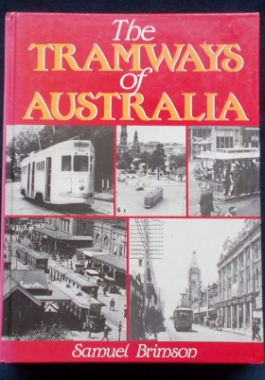
A valuable resource for anyone interested in the early rail/tram networks of Australia from the first horse-drawn trams to the steamers to the modern electrical cars. Filled with fabulous archival black and white photos, this book is divided into chapters of places, from Adelaide to Sydney and all stops in between. It also covers such things as the companies, the employees and some interesting snippets of Australian history.
-

 Pepys (1633 – 1703) was Chief Secretary for the Admiralty under both King Charles II and King James II through patronage, hard work, and his talent for administration. He was later a Member of Parliament but he is more well-known for his diary. The 1660s represent a turning point in English history, and for the main events - the Restoration, the Dutch War, the Great Plague and the Fire of London - Pepys provides a definitive eyewitness account. As well as recording public and historical events, Pepys paints a vivid picture of his personal life, from his socialising and amorous entanglements, to the theatre of the day and his work at the Navy Board. Told with high spirits, keen observation and humor, this enduring memoir serves as a window on the world of a significant decade in history. This edition edited by Ernest Rhys.
Pepys (1633 – 1703) was Chief Secretary for the Admiralty under both King Charles II and King James II through patronage, hard work, and his talent for administration. He was later a Member of Parliament but he is more well-known for his diary. The 1660s represent a turning point in English history, and for the main events - the Restoration, the Dutch War, the Great Plague and the Fire of London - Pepys provides a definitive eyewitness account. As well as recording public and historical events, Pepys paints a vivid picture of his personal life, from his socialising and amorous entanglements, to the theatre of the day and his work at the Navy Board. Told with high spirits, keen observation and humor, this enduring memoir serves as a window on the world of a significant decade in history. This edition edited by Ernest Rhys. -
 During World War II, Dr. J. Robert Oppenheimer directed the building of the atom bomb; soon afterwards he became the U.S. government's top adviser on nuclear policy. Yet in December 1953 he was suspended as a security risk by President Eisenhower. The charges: close association with Communists and obstructing development on the hydrogen bomb. Was Oppenheimer unfit to be trusted by the country he had served with such distinction? Or was he a victim of Senator Joe McCarthy's infamous anti-communist witch-hunt and of the many enemies he had made in political, scientific and military circles? After a lengthy and detailed enquiry into Oppenheimer's past, the charges against him were upheld by the Atomic Energy Commission. But the verdict only intensified public misgivings about the secret hearing. The author, former Prime Minster of England John Major, made an exhaustive examination of all the sources and has produced a penetrating analysis of one of the most disturbing events in recent American history.
During World War II, Dr. J. Robert Oppenheimer directed the building of the atom bomb; soon afterwards he became the U.S. government's top adviser on nuclear policy. Yet in December 1953 he was suspended as a security risk by President Eisenhower. The charges: close association with Communists and obstructing development on the hydrogen bomb. Was Oppenheimer unfit to be trusted by the country he had served with such distinction? Or was he a victim of Senator Joe McCarthy's infamous anti-communist witch-hunt and of the many enemies he had made in political, scientific and military circles? After a lengthy and detailed enquiry into Oppenheimer's past, the charges against him were upheld by the Atomic Energy Commission. But the verdict only intensified public misgivings about the secret hearing. The author, former Prime Minster of England John Major, made an exhaustive examination of all the sources and has produced a penetrating analysis of one of the most disturbing events in recent American history. -
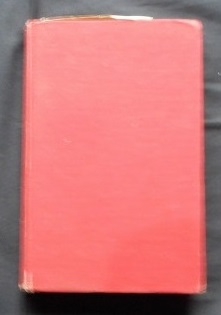
 With his usual skill, Frank Clune weaves history and contemporary fact into an exciting and significant pattern that will delight armchair travellers who accompany him on this unusual tour through Italy, Switzerland, Germany, Denmark, Austria and Greece, by plane, train and jeep. The primary reason for Clune's journey was to learn something about the work of the International Refugee Organisation, to see the migrant camps and to see displaced persons go through the initial stages that prepared them to become new Australians and listens to their hopes and dreams of Australia. With black and white photographs.
With his usual skill, Frank Clune weaves history and contemporary fact into an exciting and significant pattern that will delight armchair travellers who accompany him on this unusual tour through Italy, Switzerland, Germany, Denmark, Austria and Greece, by plane, train and jeep. The primary reason for Clune's journey was to learn something about the work of the International Refugee Organisation, to see the migrant camps and to see displaced persons go through the initial stages that prepared them to become new Australians and listens to their hopes and dreams of Australia. With black and white photographs. -
 Kevin McLeod is once more amazed by the ingenuity and determination of the families who set out to build their dream homes. From an enormous loft-style apartment hidden underground in the middle of a field to a prototype factory-made kit home built in just four weeks, this series features extraordinary builds from: The isle of Wight; The Cotswolds; Woodbridge; Stowmarket; Ipswich; Lizard Peninsula; West Cumbria and the Lake District.
Kevin McLeod is once more amazed by the ingenuity and determination of the families who set out to build their dream homes. From an enormous loft-style apartment hidden underground in the middle of a field to a prototype factory-made kit home built in just four weeks, this series features extraordinary builds from: The isle of Wight; The Cotswolds; Woodbridge; Stowmarket; Ipswich; Lizard Peninsula; West Cumbria and the Lake District. -
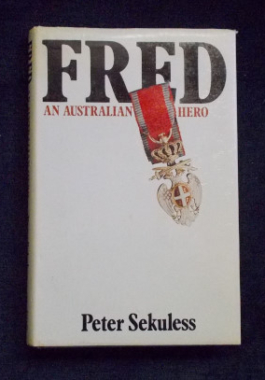 Toward the end of 1977, articles appeared in Australian newspapers about a remarkable 97 year-old Australian who had just died in Khartoum. They told of an heroic figure who had been with General Freyberg, then a junior officer, when he made his daring Dardenelles swim before the landing at Gallipoli; who had been mentioned in dispatches at the Battle of Beersheba; who had been with Lawrence of Arabia and who had won several decorations, including the George Cross for bravery under fire when he was chauffeur to the Governor-General of the Sudan at the time of his assassination in Cairo in 1924. He was one of the few Australians ever to win the coveted Serbian Eagle. This incredible Australian was Frederick Hamilton March. The newspaper articles so intrigued Sekuless than he began keeping a file on Fred March. Eventually, he travelled to Khartoum, Cairo, Gallipoli and London in a quest for information about this elusive and unknown Aussie hero to piece together the fascinating story of Fred March. Illustrated with black and white archival photographs.
Toward the end of 1977, articles appeared in Australian newspapers about a remarkable 97 year-old Australian who had just died in Khartoum. They told of an heroic figure who had been with General Freyberg, then a junior officer, when he made his daring Dardenelles swim before the landing at Gallipoli; who had been mentioned in dispatches at the Battle of Beersheba; who had been with Lawrence of Arabia and who had won several decorations, including the George Cross for bravery under fire when he was chauffeur to the Governor-General of the Sudan at the time of his assassination in Cairo in 1924. He was one of the few Australians ever to win the coveted Serbian Eagle. This incredible Australian was Frederick Hamilton March. The newspaper articles so intrigued Sekuless than he began keeping a file on Fred March. Eventually, he travelled to Khartoum, Cairo, Gallipoli and London in a quest for information about this elusive and unknown Aussie hero to piece together the fascinating story of Fred March. Illustrated with black and white archival photographs. -
 '...of words used in medicine with their derivation and pronunciation including dental, veterinary, chemical, botanicial, electrical, life insurance and other crucial terms; anatomical tables of titles in general use; the terms sanctioned by the Basle Anatomical Convention; the new British Anatomical Nomenclature; pharmaceutical preparations official in the U.S. and British Pharmacopœias or contained in the National Formulary; and comprehensive lists of synonyms.' This is indeed a very comprehensive volume and while surgical and treatment techniques may have become more modern, the language of medicine has not changed. Illustrated, with plenty to interest the current practitioner or student.
'...of words used in medicine with their derivation and pronunciation including dental, veterinary, chemical, botanicial, electrical, life insurance and other crucial terms; anatomical tables of titles in general use; the terms sanctioned by the Basle Anatomical Convention; the new British Anatomical Nomenclature; pharmaceutical preparations official in the U.S. and British Pharmacopœias or contained in the National Formulary; and comprehensive lists of synonyms.' This is indeed a very comprehensive volume and while surgical and treatment techniques may have become more modern, the language of medicine has not changed. Illustrated, with plenty to interest the current practitioner or student. -
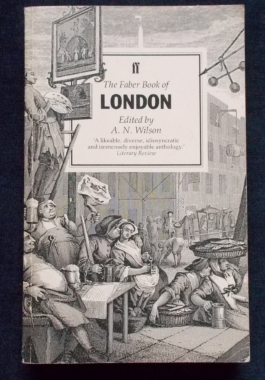 From the Great Fire of 1666 to the Blitz of the Second World War, from the building of the Tower of London to the building of Canary Wharf, London has always been much more than just a capital city. It's an eclectic, teeming, vital town which prompted Samuel Johnson to declare: 'When a man is tired of London, he is tired of life.' There's the seedy rather than the smart, the outcast rather than the established and the bizarre rather than the beautiful. Contributors include G.K. Chesterton, Daniel Defoe, Hilaire Belloc, Charles Dickens, Thomas Hardy, Michael Moorcock, Samuel Pepys, Edith Sitwell, H.G. Wells and many more. A view of London that spans the centuries, with such intriguing chapter titles as The Face On Waterloo Steps; London Molehills; Mobs, Marches, Riots and Affrays; Clubs, Taverns and Coffee Houses and 'When A Man Is Tired Of London'.
From the Great Fire of 1666 to the Blitz of the Second World War, from the building of the Tower of London to the building of Canary Wharf, London has always been much more than just a capital city. It's an eclectic, teeming, vital town which prompted Samuel Johnson to declare: 'When a man is tired of London, he is tired of life.' There's the seedy rather than the smart, the outcast rather than the established and the bizarre rather than the beautiful. Contributors include G.K. Chesterton, Daniel Defoe, Hilaire Belloc, Charles Dickens, Thomas Hardy, Michael Moorcock, Samuel Pepys, Edith Sitwell, H.G. Wells and many more. A view of London that spans the centuries, with such intriguing chapter titles as The Face On Waterloo Steps; London Molehills; Mobs, Marches, Riots and Affrays; Clubs, Taverns and Coffee Houses and 'When A Man Is Tired Of London'.




